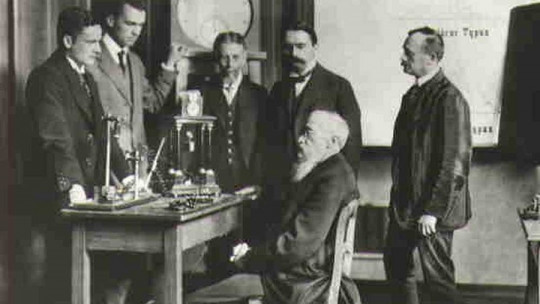Psychology is a young science, but despite its short life history it has had time to create several psychological currents that establish the way in which it is investigated, the concepts and methods used to work, and the objective pursued. .
In fact, the variety of theoretical and practical proposals about the direction that psychology can take has been surprisingly large, which does not mean that they cannot be summarized.
Next we will see what the main currents of psychology are and what are or have been its characteristics.
The most relevant currents of Psychology
Psychology as a discipline separate from philosophy appeared during the second half of the 19th century. It is normally considered that his birth coincided with the inauguration of the psychology research laboratory created by Wilhelm Wundt in 1879.
From that moment on, different approaches to psychology began to emerge, many of which appeared as a reaction to the rest. They are the following.
1. Structuralism

This current that appeared around 1890 includes members of the tradition of psychological research inaugurated by Wilhelm Wundt. Edward Titchener was its main representative and defended the idea that the objective of psychology should be to discover the basic elements of consciousness and the way in which they interact with each other to create mental processes.
Is about a reductionist perspective since it intended to investigate from the most basic elements to understand the most complex ones, and mechanistic, since it was based on the idea that a system as complex as the one that makes up our mind can be reduced to isolated parts, as if it were an engine .
Precisely because of its more academic than pragmatic approach, another current soon appeared that began to compete with this one: functionalism.
2. Functionalism
One of the main currents of psychology that appeared at the beginning of the 20th century. Functionalism, which was born in the first decade of the 20th century, represents a rejection of the structuralist approach ; Instead of focusing on studying the components of the mind, it aimed to understand mental processes. It did not focus on the “pieces”, but on the functioning, that is, the psychological functions that are carried out inside our head (and, by extension, inside our body).
Furthermore, while the approaches of structuralism had to do with very abstract and general questions, functionalism aspired to offer useful tools The idea was to know how we function in order to be able to use that knowledge in everyday and specific problems.
Although he himself dissociated himself from functionalism, William James is considered to be one of the great historical figures in the development of psychology who best embodied the approaches and concerns of this current.
3. Psychoanalysis and psychodynamics

The psychodynamic current appeared for the first time through the work of Sigmund Freud, in the last years of the 19th century. He was based on the idea that human behavior, both in his movements, thoughts and emotions, is the product of a struggle of opposing forces that try to impose themselves on the other. This fight is unconscious but according to the followers of this current it can be recognized through the interpretation of its symbolic manifestations.
Although the work of Sigmund Freud has given rise to the creation of many different psychological theories and schools of therapy, the truth is that They currently do not have scientific endorsement among other things because of the criticism that the philosopher of science Karl Popper made about this way of research.
4. Behaviorism
Behaviorism was consolidated shortly after psychoanalysis, and appeared to be a current of psychology that opposed Freud and his followers, but also many other researchers with a tendency towards mentalism. Unlike the latter, behaviorists emphasized the importance of basing research on observable elements of behavior, avoiding as much as possible unjustified speculation and avoiding the interpretation of acts in a symbolic key.
Fundamentally, behaviorists were characterized by considering that the object of study of psychology should be behavior, and not what is usually understood by “mental processes” or, of course, any type of speculation about the soul (although at a certain point Mental processes also began to be studied, although understood as behavior, just like motor behavior).
But although behaviorists wanted to base their work on the study of matter and not the soul, that does not mean that they dedicated themselves to studying the brain, just as a neurologist would do.
Unlike biopsychologists, to do their work, behaviorists They did not need to know details about what happens in our nervous system when performing certain tasks. Instead, they focused on studying the relationships created between stimuli and responses. For example, to know if a reward system works or not in a company, it is not necessary to know which neuron circuits are intervening in this process.
Thus, in this current of psychology the unit of analysis is contingency: the relationship between stimuli and their responses (both being observable and measurable). However, since measuring certain reactions to stimuli was considered immoral using human beings, they were based on experimentation with animals, which gave a lot of strength to comparative psychology.
Two of the most famous representatives of this current of psychology were John B. Watson and BF Skinner.
5. Gestalt

This current, which should not be confused with Gestalt therapy, was born in Germany to study psychological processes related to perception and with the way in which solutions are reached to new problems.
For these researchers, both by seeing an image and by having an idea we are able to create a global image about the environment and its potential, instead of limiting ourselves to accumulating information piece by piece about what surrounds us and then making these elements fit.
For example, when solving a puzzle we try until by chance we succeed, but an image of the solution to the problem appears spontaneously. Wolfgang Köhler, for example, studied how chimpanzees reach conclusions about possible ways to modify the environment to obtain food.
This group of researchers developed a series of rules, the so-called “Gestalt laws”, through which they described the processes by which our brain creates units of information qualitatively different from the data that comes to it through the senses.
6. Humanism
Technically, humanistic psychology is not characterized by proposing specific research or intervention tools, nor is it based on differentiated scientific presuppositions. What distinguishes it is the way in which psychology is linked with ethics and with a concept of the human being.
In this current it is believed that the function of psychology should not be simply to obtain information and analyze it coldly, but rather to you have to make people happy
In practice, this has meant that humanistic psychologists have drawn heavily on phenomenology and have considered that the subjective and not directly measurable should also have value for psychotherapy and research. This has earned them a lot of criticism, since it can be understood as a symptom that their orientation is dualistic.
One of the best-known representatives of this current was Abraham Maslow who theorized about the hierarchy of human needs.
7. Cognitivism
Cognitivism was consolidated as a current of psychology at the end of the 60s, and was a reaction to BF Skinner’s behaviorism It meant a return to the study of mental processes that were not taken into account by behaviorists, and this gave rise to a new concern for beliefs, emotions, decision making, etc.
However, methodologically this new current was greatly influenced by behaviorism, and used many of its intervention and research tools Currently, cognitivism is the dominant perspective.









